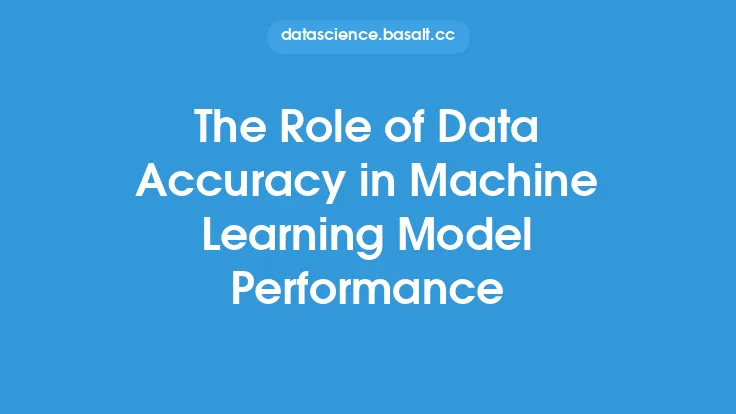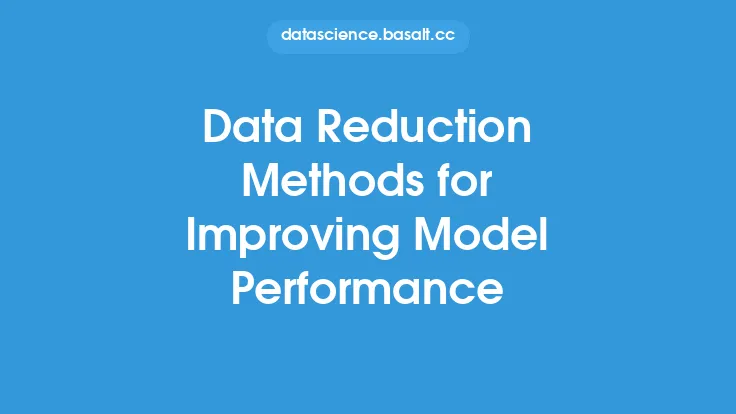Data reduction is a crucial step in the data mining process, and its role in improving model performance cannot be overstated. With the increasing amount of data being generated every day, it has become essential to reduce the dimensionality of the data to make it more manageable and improve the performance of machine learning models. In this article, we will delve into the world of data reduction and explore its significance in improving model performance.
What is Data Reduction?
Data reduction is the process of reducing the number of features or dimensions in a dataset while preserving the most important information. This is done to reduce the complexity of the data, improve model performance, and reduce the risk of overfitting. Data reduction can be achieved through various techniques, including feature selection, dimensionality reduction, and data aggregation. The goal of data reduction is to identify the most relevant features in the dataset and eliminate the redundant or irrelevant ones.
Benefits of Data Reduction
Data reduction has several benefits that make it an essential step in the data mining process. Some of the benefits of data reduction include:
- Improved model performance: By reducing the number of features in the dataset, data reduction helps to improve the performance of machine learning models. This is because the model is able to focus on the most important features and ignore the noise.
- Reduced risk of overfitting: Overfitting occurs when a model is too complex and fits the training data too closely. Data reduction helps to reduce the risk of overfitting by reducing the number of features in the dataset.
- Improved interpretability: Data reduction helps to improve the interpretability of the data by reducing the number of features and making it easier to understand the relationships between the features.
- Reduced computational cost: Data reduction helps to reduce the computational cost of training machine learning models. This is because the model has to process fewer features, which reduces the computational requirements.
Techniques for Data Reduction
There are several techniques for data reduction, including:
- Feature selection: This involves selecting the most relevant features in the dataset and eliminating the redundant or irrelevant ones. Feature selection can be done using various methods, including correlation analysis, mutual information, and recursive feature elimination.
- Dimensionality reduction: This involves reducing the number of features in the dataset using techniques such as principal component analysis (PCA), singular value decomposition (SVD), and t-distributed Stochastic Neighbor Embedding (t-SNE).
- Data aggregation: This involves aggregating the data into a smaller number of features using techniques such as grouping and averaging.
How Data Reduction Improves Model Performance
Data reduction improves model performance in several ways. Firstly, it helps to reduce the risk of overfitting by reducing the number of features in the dataset. This makes it easier for the model to generalize to new data and improves its performance on unseen data. Secondly, data reduction helps to improve the interpretability of the data by reducing the number of features and making it easier to understand the relationships between the features. This makes it easier to identify the most important features and improve the model's performance. Finally, data reduction helps to reduce the computational cost of training machine learning models, which makes it possible to train more complex models and improve their performance.
Common Challenges in Data Reduction
Despite the benefits of data reduction, there are several challenges that data scientists face when applying data reduction techniques. Some of the common challenges include:
- Identifying the most relevant features: Identifying the most relevant features in the dataset can be challenging, especially when dealing with high-dimensional data.
- Avoiding information loss: Data reduction can result in information loss, especially if the wrong features are eliminated. It is essential to ensure that the most important information is preserved during the data reduction process.
- Choosing the right technique: There are several data reduction techniques available, and choosing the right one can be challenging. The choice of technique depends on the nature of the data and the goals of the project.
Best Practices for Data Reduction
To get the most out of data reduction, it is essential to follow best practices. Some of the best practices for data reduction include:
- Understanding the data: It is essential to understand the data and the relationships between the features before applying data reduction techniques.
- Choosing the right technique: The choice of data reduction technique depends on the nature of the data and the goals of the project.
- Evaluating the results: It is essential to evaluate the results of data reduction and ensure that the most important information is preserved.
- Using domain knowledge: Domain knowledge can be useful in identifying the most relevant features and ensuring that the data reduction process is effective.
Conclusion
In conclusion, data reduction is a crucial step in the data mining process, and its role in improving model performance cannot be overstated. By reducing the number of features in the dataset, data reduction helps to improve the performance of machine learning models, reduce the risk of overfitting, and improve the interpretability of the data. There are several techniques for data reduction, including feature selection, dimensionality reduction, and data aggregation. Despite the benefits of data reduction, there are several challenges that data scientists face when applying data reduction techniques. By following best practices and using domain knowledge, data scientists can get the most out of data reduction and improve the performance of their models.





